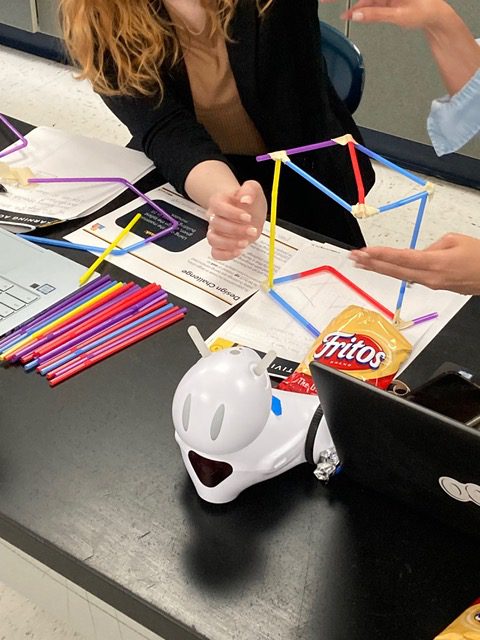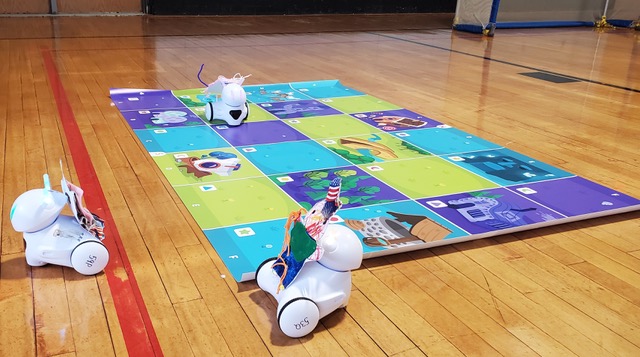
Computational Thinking Counts in Elementary Grades: Powerful STEM Teaching and Learning for the 21st Century
Project Aim
CT Counts is a professional development grant for K-5 teachers. We are interested in supporting
teachers to integrate Computational Thinking into math and science classrooms. To achieve this,
we propose to have teachers use project-based learning and design thinking to engage students in situations that can be solved with CT.
Research Questions
Our questions for this project focus on the model being developed for professional learning as well as what the participants learn by participating. Because of the COVID-19 pandemic, which has significantly altered this project, we are collecting only qualitative data to address these questions.
1. Professional Learning Model
- To what degree does this PL model engage teachers in learning about CT, support teachers in developing specific CT skills and understandings in the context of teaching STEM content, and lead to teachers’ creation and implementation of project-based or design thinking units?
- Does participation in the PL model over three years have an impact on elementary teachers’ STEM instructional practices?
- Are changes made in the ways mathematics and science are taught?
- Is CT more pervasive in the teachers’ classrooms over time?
- Are project-based and design-thinking opportunities more common over time in math and science?
- Does the nature of the projects change over the three years of the project?
- Does the nature of the implementation of projects change over the lifespan of the project?
- What kinds of supports do participating teachers need to implement CT units and lessons in their classrooms? Does the need for these supports fade over time?
Teachers’ Knowledge
- How and what do teachers learn from participating in this professional learning model?
- In what ways do teachers’ understandings of CT change?
- In what ways do teachers’ understandings of the mathematics they need to teach (PCK) change?
- In what ways do teachers’ understandings of science needed to teach change?
- In what ways do teachers’ technological pedagogical content knowledge change?
Why We Do This Work
We recognize that all students need to have access to computational thinking. Along with other 21 st century skills, computational thinking (CT) is a powerful tool for addressing a wide variety of problems. Learning CT opens pathways into STEM disciplines for students. Too often, though, CT is saved for out-of-school experiences that are not readily accessible by all students and many traditional classroom teachers have limited experience engaging in CT activities. Thus, we are trying to impact the classroom experiences of students by engaging teachers in hands-on experience with robots, offline coding, design thinking, and project-based learning all grounded in their classroom teaching.
Project Partners
Project Abstract
This 4-year STEM+C grant aims to develop a professional development model for bringing computation thinking into the formal mathematics and science curriculum for grades 3-5 in one district. To achieve this goal, we will implement a three-year professional learning model that includes summer workshops and ongoing support throughout the year. In the summers, participating teachers will learn about design thinking, project-based learning, and computational thinking in addition to being introduced to new technologies. During the year, in-class implementation support will be offered and monthly video club sessions will be conducted to sensitize teachers to noticing in their classrooms. Throughout the process, teachers will co-design and implement projects-based lessons and design-thinking projects that they have designed to integrate computational thinking into math and science.
The research will focus on the professional learning model in which teachers will be creating project-based units that incorporate computational thinking into math and science. We have chosen to partner with schools in one urban district to engage in design-based implementation research in which we work closely with a group of teachers to examine and refine our model of professional learning. Given the research at the elementary level, and studies in language, culture and linguistics, we argue that it is important to engage children in computational thinking and disciplinary content and practices early in their academics through project-based and design-thinking projects and activities. Until now, most computational thinking projects have been limited to informal learning environments because of constraints teachers face. By working with teachers as co-developers, we raise the relevance and “fit” of the units for the schools.
The outcomes of this research effort will include: teacher-developed project-based or design thinking lessons; a longitudinal study of teacher professional development for promoting computational thinking in the STEM disciplines in elementary grades; a refined and scalable model for professional development; and a set of video teaching cases that provide teachers with models of implementation of such units in their own classrooms that highlight ways to recognize a wide variety of student thinking strategies, particularly when student thinking is not verbal. We will also develop an annual conference at which teachers from the district can learn from each other and can share their own experiences.
Intellectual Merit
This project takes seriously that computational thinking is a 21st century skill that all learners should develop. Because mathematics and science can benefit from the kinds of reasoning developed in computational thinking, they are a natural fit for integrating it into the curriculum. Our approach engages the teachers as co-learners to explore how CT can be incorporated into the STEM content they already teach. In short, this project takes a first step in creating opportunities for students and teachers to engage in the kinds of reasoning that typify the anticipated needs of the workplace as the century progresses.
Broader Impact
We are interested in supporting access to computational thinking in the context of engaging with mathematics and science content for all students. Too often, computational thinking activities are relegated to afternoon clubs or summer workshops that limit student access. And, too often, only one or two teachers in a school see themselves as the “computer” teacher. This project moves away from these norms by building a scalable professional development model that can be used in subsequent projects. The researchers will disseminate findings from the research as well as the curriculum units through a wide variety of venues including journals and academic conferences, statewide teacher conferences, and through a presence on the Kaput Center for Research and Innovation in STEM Education’s website.
Ready, Set, STEM!




For more information, visit kaputcenter.org/projects/present-work/computational-thinking-counts/


